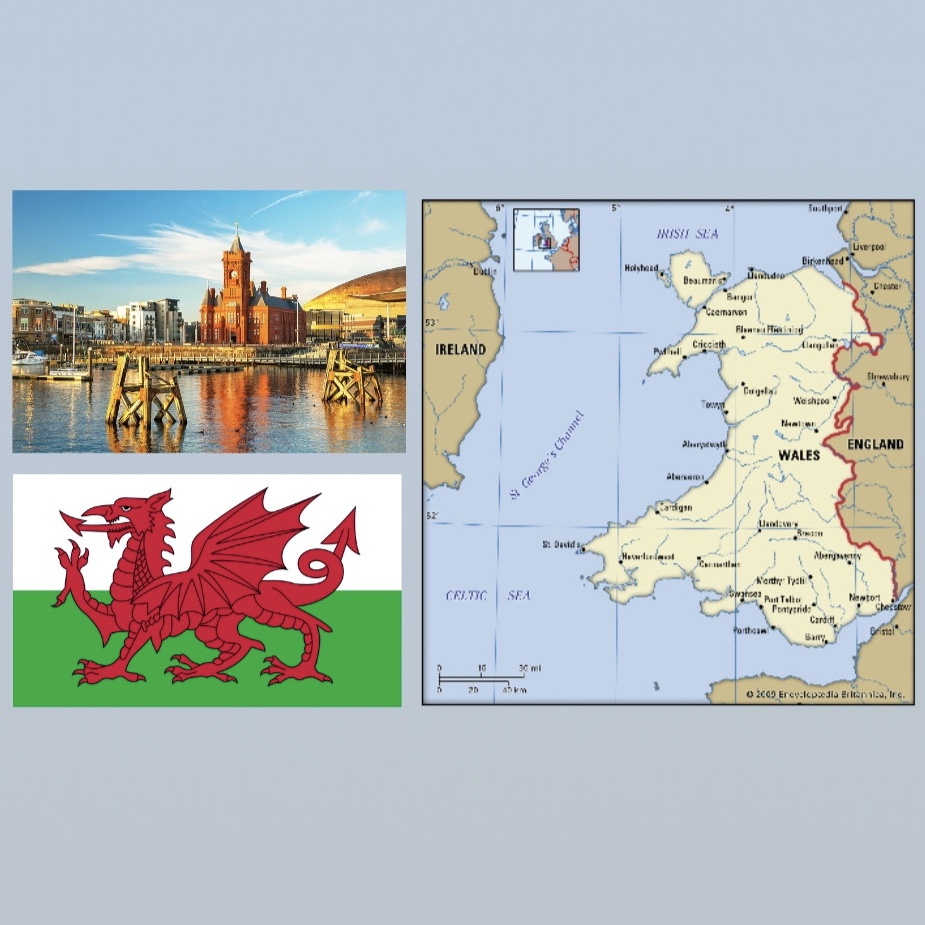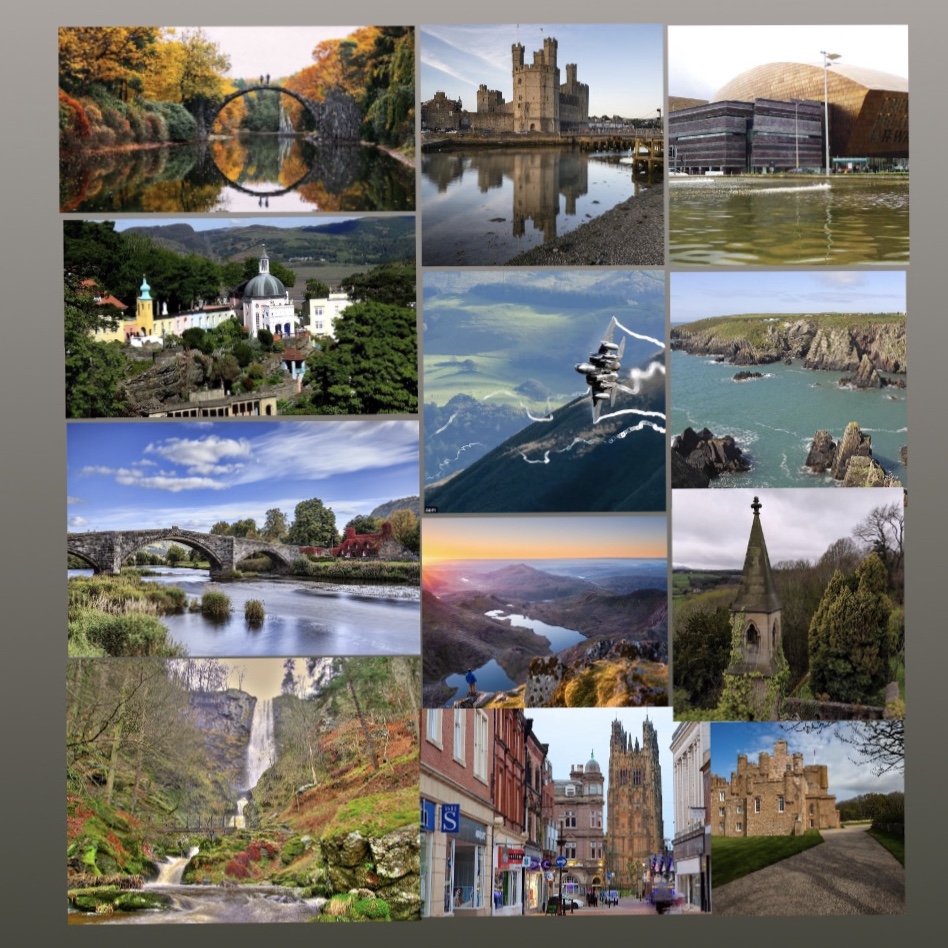Dưới đây là những điều bạn cần biết về Wales, A+ English chắc rằng bạn sẽ rất thú vị khi khám phá nó đấy!
Nội dung chính
1.Vị trí địa lý
Wales là một quốc gia thuộc Vương quốc Liên hiệp Anh và Bắc Ireland và nằm trên đảo Anh. Nó có biên giới với Anh về phía đông, trong khi biển Ireland nằm về phía bắc và tây, còn eo biển Bristol nằm về phía nam.

Nó chiếm dưới một phần mười tổng diện tích của Vương quốc Liên hiệp Anh và Bắc Ireland, với 20.779 kilômét vuông (8.020 dặm vuông Anh). Địa hình Wales hầu hết là đồi núi, song miền nam có ít đồi núi hơn miền bắc và miền trung. Khu vực cư dân và công nghiệp chính nằm tại miền nam.
Tổng diện tích 20.779 km². Wales có trên 2.700 km đường bờ biển và địa hình phần lớn là vùng núi, các đỉnh núi cao nằm tại các khu vực miền bắc và miền trung.
Thủ đô: Cardiff và cũng là phố lớn nhất tại xứ Wales
2. Dân số
Bạn có biết dân số Wales đạt hơn 3 triệu người vào năm 2011, sống trên tổng diện tích 20.779 km².
Theo điều tra nhân khẩu năm 2011, dân số Wales đạt 3.063.456, là con số cao nhất trong lịch sử. Năm 2011, 27% (837.000) tổng dân số Wales không sinh tại Wales,[185] trong đó 636.000 người (21% tổng dân số Wales) sinh tại Anh. Các khu vực dân cư và công nghiệp chính nằm tại miền nam Wales, bao gồm các thành phố Cardiff, Swansea và Newport cùng các thung lũng lân cận, một lượng dân số đáng kể khác sống tại miền đông-bắc quanh Wrexham và Flintshire.
Wales kém đa dạng về dân tộc so với tất cả các vùng bên Anh. 93,2% tự phân loại là người Anh Quốc da trắng (gồm người Wales, người Anh, người Scotland, người Bắc Ireland. Khoảng 2,4% nhận là “người da trắng khác” (bao gồm người Ireland), 2,2% là người gốc Á, 1% là người hỗn chủng, và 0,6% là người da đen (người Phi, Caribe, hay người Anh da đen). Tỷ lệ người Anh Quốc da trắng thấp nhất là tại Cardiff với 80,3%.
3. Kinh tế
Tổng giá trị gia tăng (GVA) tại Wales vào năm 2010 là 45,5 tỷ bảng, tức 15.145 bản/người; 74,0% mức trung bình của toàn Anh Quốc, và là mức GVA bình quân thấp nhất tại Anh Quốc.
Cardiff từng là cảng xuất khẩu than đá lớn nhất thế giới, và trong vài năm trước thế chiến I nơi đây từng vận chuyển khối lượng trọng tải hàng hóa nhiều hơn Luân Đôn hay Liverpool.
Vào cuối thập niên 1970 và đầu thập niên 1980, Wales thành công trong việc thu hút đầu tư nước ngoài khi đạt tỷ lệ cao hơn bình quân trong Anh Quốc.
Do đất đai có chất lượng kém, phần lớn Wales không phù hợp cho trồng trọt, trọng tâm nông nghiệp từ lâu tập trung vào chăn nuôi. Wales thu hút lượng lớn du khách nhờ cảnh quan (có ba vườn quốc gia) và 45 bãi biển Blue Flag, cũng như văn hóa độc đáo, du lịch giữ vai trò sống còn đặc biệt trong kinh tế của các khu vực nông thôn
Wales nỗ lực phát triển hoặc thu hút công việc giá trị gia tăng cao trong các lĩnh vực như tài chính hay nghiên cứu và phát triển, song Wales thiếu một trung tâm vùng đô thị lớn.
4. Khí hậu
Wales nằm trong vùng ôn đới bắc; có khí hậu đại dương, hay thay đổi, và là một trong những quốc gia mưa nhiều nhất tại châu Âu.[128][129] Thời tiết Wales thường có nhiều mây, mưa và gió, với mùa hè ấm và mùa đông dịu.
Nhiệt độ trung bình năm tại duyên hải đạt đến 10,5 °C, các khu vực nội lục ở mức kém hơn 1 °C. Nhiệt độ mát hơn theo độ cao, nhiệt độ trung bình năm giảm trung bình khoảng 0,5 °C mỗi 100 m.
Thời gian ban ngày vào giữa đông chỉ hơn bảy tiếng rưỡi. Wales có biến thiên rộng về địa lý, gây ra khác biệt địa phương về ánh nắng, mưa và nhiệt độ.
Vùng cao của Wales có nhiều mưa nhất, thông thường có trên 50 ngày mưa trong các tháng mùa đông (tháng 12, 1, 2), giảm xuống còn 35 ngày mưa vào các tháng mùa hè (tháng 6, 7, 8). Lượng mưa hàng năm tại Snowdonia trung bình là từ 3.000 mm đến 5.000 mm. Có khả năng xảy ra mưa đá hoặc tuyết khi nhiệt độ dưới 5 °C, và tuyết có xu hướng nằm trên mặt đất trung bình 30 ngày mỗi năm. Tuyết rơi vài lần trong mùa đông tại các vùng nội lục, song quanh bờ biển thì tương đối hiếm. Lượng mưa hàng năm bình quân tại các khu vực này có thể dưới 1.000 mm.
5. Ngôn ngữ
Bạn cần biết về Wales khi ngôn ngữ ở đây thuộc ngôn ngữ Celtic . Nó có ảnh hưởng nhất trong số các ngôn ngữ Celtic hiện có. Đạo luật Ngôn ngữ Wales 1993 và Đạo luật Chính phủ Wales 1998 quy định tiếng Anh và tiếng Wales được đối đãi trên cơ sở bình đẳng, cả hai được sử dụng làm ngôn ngữ làm việc trong Quốc hội. Cả tiếng Anh và tiếng Wales cùng là ngôn ngữ chính thức. Tiếng Wales còn được công nhận theo luật là có “địa vị chính thức”. Hầu hết mọi người tại Wales nói tiếng Anh, đây là ngôn ngữ chính tại hầu khắp đất nước.
6. Văn hoá
Những văn hóa nổi tiếng bạn cần biết về Wales:
Xứ Wales nổi tiếng với loài hoa chuông xanh. Loài hoa chuông xanh được tìm thấy ở khắp cánh rừng châu Âu, tiêu biểu nhất là ở xứ Wales.

Tất cả đều nằm ở phía bắc của xứ Wales, bao gồm Snowdon (ngọn núi cao nhất), Gresford Bells (những chiếc chuông trên một nhà thờ cổ ở All Saints, Gresford), Llangollen Bridge ở Flintshire, Wrexham Steeple, những cây thủy tùng ở Overton và thác nước Pistyll Rhaeadr là 7 kỳ quan thiên nhiên của Wales là danh sách 7 địa điểm văn hóa và thắng cảnh ở Wales
Wales còn được biết đến là vùng đất của ca hát
Hầu hết trẻ em ở đây đều tham gia một ca đoàn nào đó hay chơi nhạc cụ. Những người nổi tiếng gốc Wales bao gồm: Richard Burton, Sir Anthony Hopkins, Tom Jones, Catherine Zeta-Jones, Shirley Bassey, Timothy Dalton và Charlotte Church.

Lễ hội Nghệ thuật Eisteddfod được tổ chức ở Llanelli, miền nam xứ Wales. Nó bắt đầu từ ngày 1 đến ngày 9 tháng 8 hàng năm. Lễ hội diễn ra trong tuần đầu tiên của tháng 8 ở nhiều địa điểm khác nhau. Được xem là một nét truyền thống văn hoá của người xứ Wales.
Wales có thể có một trong các truyền thống văn học không bị gián đoạn lâu đời nhất tại châu Âu. Gwyn Thomas, Vernon Watkins, và Dylan Thomas là những tác giả được biết đến. Điển hình như tác phẩm nổi tiếng nhất của Dylan Thomas là kịch truyền thanh Under Milk Wood. Nó được phát sóng lần đầu vào năm 1954.
Bảo tàng Quốc gia Wales có bảy địa điểm trên toàn quốc. Trong đó có Bảo tàng Quốc gia Cardiff, Bảo tàng Lịch sử Quốc gia St Fagans và Bảo tàng Than đá Quốc gia Big Pit.
Các món ăn truyền thống gồm có laverbread (làm từ laver (Porphyra umbilicalis), một loại rong biển); bara brith (bánh mì quả); cawl (thịt cừu ninh); cawl cennin (súp tỏi tây); bánh ngọt Wales; và thịt cừu Wales. Sò nứa thỉnh thoảng giữ vai trò là bữa sáng truyền thống cùng với thịt xông khói và laverbread.

7. Lịch sử
Sử gia John Davies cho rằng Gruffydd là quốc vương người Wales duy nhất cai trị toàn bộ lãnh thổ Wales trong giai đoạn 1057-1063.
Dù Quy chế Rhuddlan vào năm 1284 tạo cơ sở hiến pháp cho chính phủ hậu chinh phục của thân vương quốc tại miền bắc của Wales từ năm 1284 cho đến năm 1536. Mãi đến năm 1536 thì Wales và Anh mới chính thức liên hiệp. Ngay sau đó, luật Wales bị luật Anh thay thế hoàn toàn. Theo một quá trình được gọi là Đạo luật Liên hiệp.
Wales và Scotland tổ chức trưng cầu dân ý vào năm 1997. Để lựa chọn thiết lập một hình thức tự quản. Tại Wales, quá trình phân quyền sau đó được bắt đầu bằng Đạo luật Chính phủ Wales 1998. Lập ra Quốc hội Wales (National Assembly for Wales).
Quyền lực của Bộ trưởng Wales được chuyển giao cho chính phủ phân quyền vào ngày 1 tháng 7 năm 1999. Trao cho Quốc hội quyền quyết định cách chi tiêu và quản lý ngân sách. Chính phủ Anh Quốc trao cho Wales trong các lĩnh vực được phân quyền.
Đạo luật Chính phủ Wales năm 2006 sửa đổi đạo luật năm 1998. Nâng cao quyền lực của Quốc hội Wales, trao cho họ quyền lực lập pháp tương tự như của Nghị viện Scotland và Nghị hội Bắc Ireland.
8. Những thành tựu đạt được
Những thành tựu bạn cần biết về Wales:
Chơi quần vợt trên sân cỏ (Lawn tennis) xuất hiện lần đầu tiên ở Wales vào những năm 1800.
Bức điện đầu tiên qua sóng radio do Marconi gửi đi vào năm 1897 là giữa hai địa điểm thuộc xứ Wales.
Nhà toán học Robert Recorde đến từ Pembrokeshire là người đã phát minh ra dấu “=”.
Pryce Jones đến từ Newtown Montgomeryshire là một trong những doanh nhân đầu tiên trên thế giới thành công với phương thức kinh doanh đặt hàng qua bưu điện (Mail Order).
9. Những địa điểm nổi tiếng tại Wales

Những địa điểm nổi tiếng bạn cần biết về Wales:
Snowdonia
Công viên quốc gia Brecon Beacons
Cầu Devil và Hafod Estate
Lâu đài Caernarfon
Bờ biển Pembrokeshire
Portmeirion
Bảo tàng lịch sử quốc gia St Fagans
Trung tâm Thiên niên kỷ Wales
10. Những trường đại học danh tiếng
Những trường đại học danh tiếng bạn cần biết về Wales:

Aberystwyth University
Bangor University
Cardiff Metropolitan University
Cardiff University
Wrexham Glyndŵr University
Swansea University
University of South Wales
University of Wales Trinity Saint David.
Qua những điều bạn cần biết về Wales, và những thông tin hữu ích bên trên ,Anh ngữ A+ chắc rằng bạn đã có thêm nhiều kiến thức về xứ sở này rồi đúng không nào?
WALES
Geography
Wales is a country in the United Kingdom of Great Britain and Northern Ireland and is located on the island of Great Britain. It borders England to the east, the Irish Sea to the north and west, and the Bristol Strait to the south.
It occupies less than one-tenth of the total area of the United Kingdom of Great Britain and Northern Ireland, with 20,779 square kilometers (8,020 sq mi). Wales’ topography is mostly mountainous, but the south has fewer hills than the north and central regions. The main residential and industrial areas are located in the south.
The total area is 20,779 km². Wales has over 2,700 km of coastline and is largely mountainous, with high peaks in the northern and central regions.
Capital: Cardiff and also the largest city in Wales.
Population
Wales’ population reached 3,063,456 according to the 2011 census, the highest number in history. In 2011, 27 percent (837,000) of Wales’ total population was not born in Wales,[185] with 636,000 people (21 percent of Wales’ total population) born in England. The main residential and industrial areas are in south Wales, including the cities of Cardiff, Swansea, and Newport, as well as the surrounding valleys, with a sizable population in the north-east around Wrexham and Flintshire.
Wales has a lower ethnic diversity than the rest of England. 93.2 percent identified as Caucasian British (Welsh, English, Scots, and Northern Irish). Approximately 2.4 percent identified as “other white” (including Irish), 2.2% are of Asian descent, 1% are mixed race, and 0.6 percent are black (African, Caribbean, or British Black). Cardiff has the lowest percentage of white British people, at 80.3%.
Economy
Wales had a total value added (GVA) of £45.5 billion in 2010, or 15,145 copies per person, which was 74.0 percent of the UK average and the lowest average GVA in the UK.
Cardiff was once the world’s largest coal export port, carrying more tonnage than London or Liverpool in the years preceding World War I.
In the late 1970s and early 1980s, Wales was more successful than the rest of the UK in attracting foreign investment.
Because much of Wales is unsuitable for farming due to poor land quality. The focus of agriculture has long been on livestock. Wales attracts a large number of visitors due to its landscape (three national parks) and 45 Blue Flag beaches, as well as its distinct culture. Tourism is especially important in rural economies.
Wales strives to develop or attract high-value-added work in industries such as finance and research and development, but the country lacks a major metropolitan center.
Climate
Wales is located in the northern temperate zone, has a variable oceanic climate, and is one of Europe’s rainiest countries. [128][129] Formalized paraphrase The weather in Wales is typically cloudy, rainy, and windy, with mild winters and warm summers.
The annual average temperature in coastal areas is 10.5 °C, while it is less than 1 °C in inland areas. Temperatures drop with altitude, with the average annual temperature dropping by about 0.5°C per 100 m.
In the middle of winter, the day lasts just over seven and a half hours. Wales has a wide geographic variation, resulting in local variations in sunshine, rain, and temperature.
The highlands of Wales receive the most rain. With over 50 rainy days on average during the winter months (December, January, and February), and only 35 rainy days during the summer months (June, July and August). Snowdonia receives between 3,000 and 5,000 mm of rain per year on average. When temperatures fall below 5 °C, hail or snow may fall. And snow may remain on the ground for an average of 30 days per year. Snow falls several times during the winter in the interior, but it is uncommon along the coast. In these areas, the average annual rainfall can be less than 1,000 mm.
Language
The language is related to the Celtic language family. It is the most well-known of the Celtic languages. The Welsh Languages Act of 1993 and the Welsh Government Act of 1998 provide for equal treatment of English and Welsh. Both of which are used as working languages in Parliament. English and Welsh are both official languages. Welsh is also legally recognized as a language with “official status”. The majority of people in Wales speak English, which is the primary language in the majority of the country.
Culture
Wales is well-known for its bluebells. Bluebells can be found throughout Europe’s forests, most notably in Wales.
All are in the north of Wales, including Snowdon (the highest mountain), Gresford Bells (the bells on an old church in All Saints, Gresford), Llangollen Bridge in Flintshire, Wrexham Steeple, the aquatic plants Overton, and Pistyll Rhaeadr waterfall.
Wales is also known as the “Land of Singing,”
As the majority of children in the country sing in choirs or play musical instruments. Richard Burton, Sir Anthony Hopkins, Tom Jones, Catherine Zeta-Jones, Shirley Bassey, Timothy Dalton, and Charlotte Church are all famous Welsh people.
Every year, from August 1 to 9, Llanelli, south Wales, hosts the Eisteddfod Arts Festival. The festival takes place in various locations during the first week of August. It is regarded as a Welsh cultural tradition.
Wales may have one of Europe’s oldest continuous literary traditions. Authors such as Gwyn Thomas, Vernon Watkins, and Dylan Thomas are well-known. Dylan Thomas’s most famous work, for example, is the radio play Under Milk Wood, which was first broadcast in 1954.
The National Museum of Wales is spread across the country. With seven locations including the National Museum of Cardiff, the National History Museum of St Fagans. And the Big Pit National Coal Museum.
Laverbread (made from the seaweed porphyra umbilicalis); bara brith (fruit bread); cawl (broiled lamb); cawl cennin (leek soup); Welsh pastries; and Welsh lamb are all traditional dishes. Scallops, along with bacon and laverbread, are sometimes served as a traditional breakfast.
History
According to historian John Davies, Gruffydd was the only Welsh monarch who ruled over all of Wales between 1057 and 1063.
Although the Statute of Rhuddlan of 1284 served as the constitutional foundation for the principality’s post-conquest government in northern Wales from 1284 to 1536. Wales and England were not officially united until 1536. Welsh law was quickly superseded by English law, a process known as the Acts of Union.
Wales and Scotland held referendums in 1997 to determine their level of self-government. The Welsh Government Act 1998 established the National Assembly for Wales, completing the decentralization process in Wales.
On July 1, 1999, the powers of the Minister of Wales were transferred to the decentralized government, giving Parliament the authority to decide how to spend and manage the British government budget allocated to Wales in the areas assigned to it. permission is granted
The Welsh Government Act 2006 amends the 1998 act, giving the Welsh Parliament the same legislative powers as the Scottish Parliament and the Northern Ireland Assembly.
Some of famous place in Wales
Snowdonia
Brecon Beacons National Park
Devil’s Bridge and Hafod Estate
Castle Caernarfon
Pembrokeshire Coast
Portmeirion
St Fagans . National Historical Museum
Wales Millennium Center
Outstanding achievement
Lawn tennis first appeared in the 1800s in Wales.
In 1897, Marconi sent the first radio telegram between two locations in Wales.
The “=” sign was invented by Pembrokeshire mathematician Robert Recorde.
Pryce Jones of Newtown Montgomeryshire was one of the world’s first entrepreneurs to be successful with a mail order business.
Wales’s Reputable Universities
Aberystwyth University
Bangor University
Cardiff Metropolitan University
Cardiff University
Wrexham Glyndŵr University
Swansea University
University of South Wales
University of Wales Trinity Saint David
Qua những điều cần biết về Wales, A+ English mong có thể giúp các bạn bổ sung thêm nhiều kiến thức bổ ích về quốc gia này







